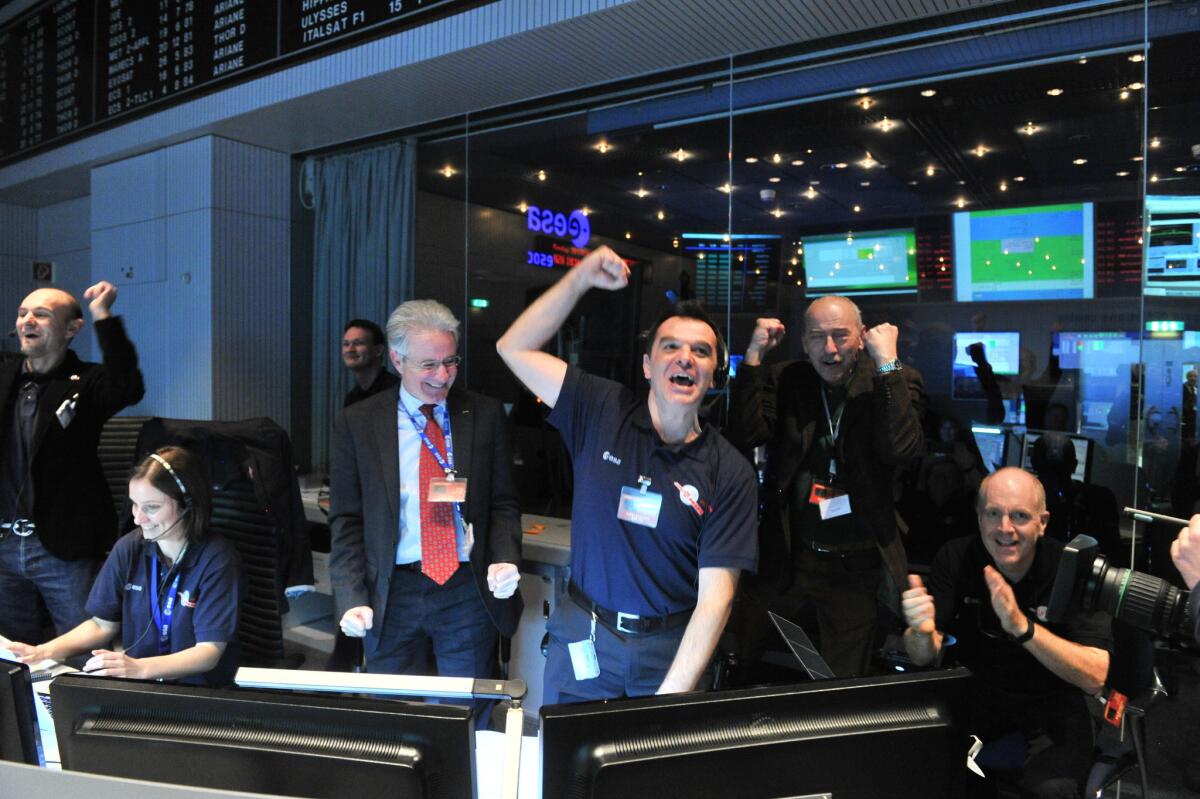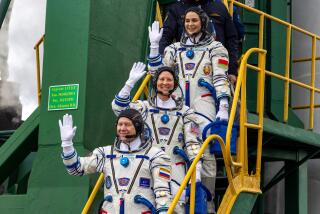‘Hello, world’: Rosetta spacecraft wakes for comet-chasing mission

Nervous anticipation gave way to jubilation on Monday when the European Space Agency’s Rosetta comet-chaser spacecraft emerged from almost three years of induced, energy-saving sleep to report it was ready to carry out its history-making $1 billion mission.
Rosetta alerted scientists at the ESA mission control center in Darmstadt, Germany, that it was awake and ready to rev up and rendezvous with the 67P/Churyumov-Gerasimenko comet in August.
The message sent from the spacecraft still 5.6 million miles from its comet destination reached Earth at 7:18 p.m. Central European Time (11:18 a.m. PST) and triggered a preprogrammed tweet of “Hello, world!” in several languages.
Confirmation that its 31-month induced sleep had ended on schedule had been expected nearly 40 minutes earlier, making for some tense waiting among the mission specialists, the ESA said in its report on the wake-up call.
Rosetta was powered down in June 2011 as it reached a distance of 500 million miles from the sun, beyond the point where the solar-powered spacecraft could recharge its energy systems, ESA reported. Now that the spacecraft’s orbit has brought it back to within 420 million miles of the sun, the systems have turned themselves on again and launched a series of operational checks ahead of the decade-old mission’s denouement.
“This was one alarm clock not to hit snooze on, and after a tense day we are absolutely delighted to have our spacecraft awake and back online,” said Rosetta mission manager Fred Jansen.
Comets are thought to be the building blocks of the universe, holding clues to the development of planets and life-sustaining elements like water, ESA said. If the mission can accomplish its aim of landing a probe on the surface of 67P and collecting samples of the comet’s composition, scientists hope to learn about the origins of Earth, the space agency said.
Rosetta, named for the block of stone that helped archeologists decipher ancient Egyptian hieroglyphs, is expected to begin transmitting images of the comet as it nears to about 1.25 million miles in May. In August, the spacecraft will rendezvous with the comet and begin a two-month project of mapping its surface.
A Nov. 11 landing is planned of Rosetta’s 220-pound Philae probe, the first attempt by aeronautic engineers to fix a spacecraft onto a gas- and dust-spewing comet. Philae will have to use ice screws and harpoons to prevent it being bounced back into space after touchdown, the ESA report said.
“Philae’s job is to sample the pristine icy material, looking for clues to the origins of Earth’s oceans and of life itself,” the New Scientist online magazine said of the mission.
After the surface exploration is complete, Rosetta will “escort” the comet through the rest of 2015, documenting its approach to the sun, which will take it as close as 115 million miles on Aug. 13, ESA said.
Rosetta’s mission is expected to build on the achievements of the Giotto spacecraft, which returned the first close-up images of a comet nucleus as it flew past Halley’s Comet in 1986, ESA said.
The 20-nation ESA was created in 1975 to advance Europe’s space capability and ensure that investment in space delivers benefits to the citizens of Europe and the world, according to the agency’s mission statement.
Twitter: @cjwilliamslat
More to Read
Start your day right
Sign up for Essential California for news, features and recommendations from the L.A. Times and beyond in your inbox six days a week.
You may occasionally receive promotional content from the Los Angeles Times.







